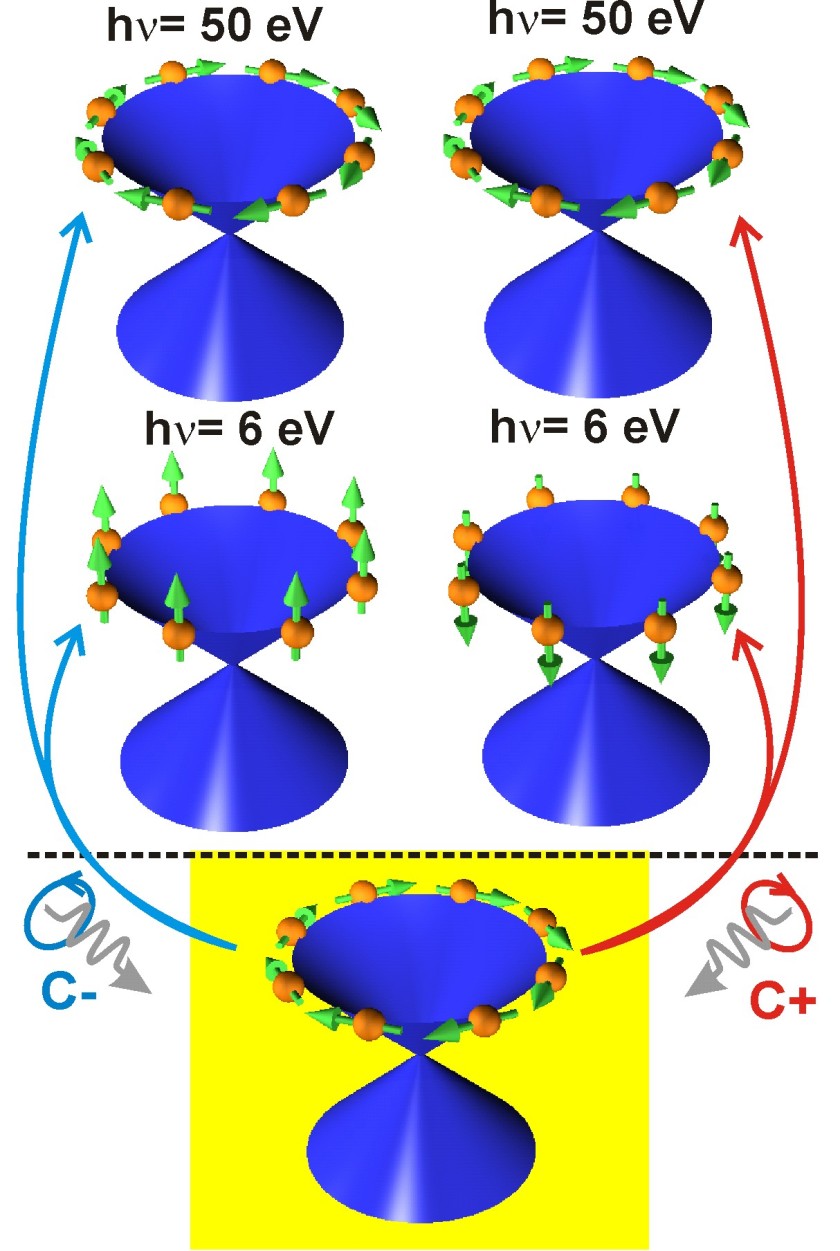How to use light to manipulate the spin in topological insulators

The picture shows the characteristic spin texture (arrows) in a topological insulator and how it is manipulated by circularly polarized light. © Rader/Sachez-Barriga/HZB
Researchers at HZB investigated the topological insulator bismuth selenide (Bi2Se3) by spin-resolved photoelectron spectroscopy at BESSY II. They found an astonishing difference depending on whether it is illuminated by circularly polarized light in the vacuum ultraviolet (50 electron volts, eV) and in the ultraviolet spectral range (6 eV). This result could help explaining how spin currents can be generated in topological insulators.
In the former case, the emitted electrons display the characteristic spin texture of topological insulators, which is aligned on a circle in the surface plane, similarly to a roundabout road sign. In the latter case, however, the spins do not only rotate completely out of this plane but also take on the spin direction imposed by the right or left circularly polarized light.
HZB researchers expect that this manipulation of the electron spin by light and the insight into its preconditions will be most useful for the generation of lossless spin currents in topological insulators.
Topological insulators are a novel state of matter with an insulating bulk and a metallic surface, which are interesting candidates for novel devices in future information technologies. Light-induced spin manipulation is one of the processes involved.The present work reveals the conditions for the generation of dissipationless spin currents in topological insulators.
Their results have just been accepted for publication in Physical Review X, the new top journal of the Americal Physical Society.
OR
https://www.helmholtz-berlin.de/pubbin/news_seite?nid=13928;sprache=en
- Copy link
-
Ernst Eckhard Koch Prize and Innovation Award on Synchrotron Radiation 2025
At the 27th BESSY@HZB User Meeting, the Friends of HZB honoured the dissertation of Dr Enggar Pramanto Wibowo (Friedrich-Alexander University Erlangen-Nuremberg). The Innovation Award on Synchrotron Radiation 2025 went to Prof. Tim Salditt (Georg-August-University Göttingen) and Professors Danny D. Jonigk and Maximilian Ackermann (both, University Hospital of RWTH Aachen University).
-
Synchrotron radiation sources: toolboxes for quantum technologies
Synchrotron radiation sources generate highly brilliant light pulses, ranging from infrared to hard X-rays, which can be used to gain deep insights into complex materials. An international team has now published an overview on synchrotron methods for the further development of quantum materials and technologies in the journal Advanced Functional Materials: Using concrete examples, they show how these unique tools can help to unlock the potential of quantum technologies such as quantum computing, overcome production barriers and pave the way for future breakthroughs.
-
Peat as a sustainable precursor for fuel cell catalyst materials
Iron-nitrogen-carbon catalysts have the potential to replace the more expensive platinum catalysts currently used in fuel cells. This is shown by a study conducted by researchers from the Helmholtz-Zentrum Berlin (HZB), Physikalisch-Technische Bundesanstalt (PTB) and universities in Tartu and Tallinn, Estonia. At BESSY II, the team observed the formation of complex microstructures within various samples. They then analysed which structural parameters were particularly important for fostering the preferred electrochemical reactions. The raw material for such catalysts is well decomposed peat.
